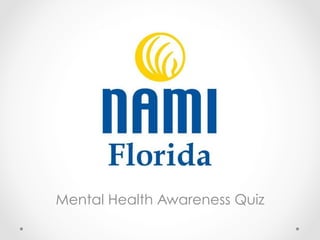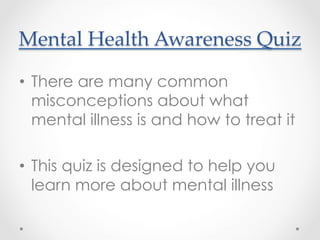NAMI Florida: Mental Health Awareness Quiz
- 1. Mental Health Awareness Quiz
- 2. Mental ?Health ?Awareness ?Quiz ?? There are many common misconceptions about what mental illness is and how to treat it ?? This quiz is designed to help you learn more about mental illness
- 3. Question ?1: ¡°Stigma¡± refers to: A.? A plan of treatment agreed to by patient and doctor. B.? Lack of knowledge about mental health. C.? Societal prejudice that can prevent people in need from speaking up or seeking help.
- 4. Question ?1: ¡°Stigma¡± refers to: C.? Societal prejudice that can prevent people in need from speaking up or seeking help. There continues to be a stigma associated with mental illness that contributes to feelings of shame and guilt and thereby prevents people from asking for help.
- 5. Question ?2: ¡°Mental health¡± refers to: A.? Achieving a period of 12-18 months without a psychotic episode. B.? Striking a balance in all aspects of your life¡ª social, physical, spiritual, economic, mental. C.? A constant feeling of contentment.
- 6. Question ?2: ¡°Mental health¡± refers to: B.? Striking a balance in all aspects of your life¡ª social, physical, spiritual, economic, mental. Generally speaking, good mental health means achieving a balance between all aspects of life- social, physical, spiritual and psychological.
- 7. Question ?3: Who is most likely to get a mental illness? A.? Poor, uneducated people. B.? Mental illness can affect anyone, regardless of intelligence, social class, or income level. C.? People with stressful jobs.
- 8. Question ?3: Who is most likely to get a mental illness? B.? Mental illness can affect anyone, regardless of intelligence, social class or income level. No one, regardless of intelligence, social status, economic condition or educational level is immune from suffering from mental illness. Mental illness can affect anyonel.
- 9. Question ?4: Clinical depression is: A.? Severe feelings of worthlessness, sadness and emptiness that last for several weeks and begin to interfere with a person's work and social life. B.? Sadness or disappointment. C.? Depression brought on by frequent trips to a hospital or dental clinic.
- 10. Question ?4: Clinical depression is: A.? Severe feelings of worthlessness, sadness and emptiness that last for several weeks and begin to interfere with a person's work and social life. Clinical depression is severe feelings of worthlessness, sadness and emptiness that last for several weeks and begin to interfere with a person's work and social life.
- 11. Question ?5: What does SAD stand for? A.? Simple Anxiety Defect B.? It is a short form of ¡°sadness.¡± C.? Seasonal Affective Disorder¡ªa type of depression that follows a seasonal pattern.
- 12. Question ?5: What does SAD stand for? C.? Seasonal Affective Disorder¡ªa type of depression that follows a seasonal pattern. Seasonal Affective Disorder is marked by an increase in symptoms of depression in October and November and then a decrease in April and May.
- 13. Question ?6: Anorexia is the most common eating disorder. A.? True B.? False
- 14. Question ?6: Anorexia is the most common eating disorder. B.? False Binge eating disorder (or compulsive over eating) is the most common, followed by bulimia, and anorexia is the least common. Bulimia can be life threatening because purging and over exercising can both lead to heart failure. Anorexia can also be life threatening, and is especially so if someone has a comorbid alcohol or drug addiction.
- 15. Question ?7: Asking someone directly about suicidal intent increases his/her risk of suicide. A.? True B.? False
- 16. Question ?7: Asking someone directly about suicidal intent increases his/her risk of suicide. B.? False Asking someone directly about suicidal intent actually lowers anxiety, opens up communication and lowers the risk of an impulsive act.
- 17. Question ?8: Women attempt suicide more often than men. A.? True B.? False
- 18. Question ?8: Women attempt suicide more often than men. A.? True While women attempt suicide more often than men, men are more likely than women to die by suicide.
- 19. Question ?9: Cross cultural studies of suicide suggest: A.? It is totally absent in many cultures B.? It is found in all cultures and ethnic groups C.? It is more prevalent in low socio-economic groups
- 20. Question ?9: Cross cultural studies of suicide suggest: B.? It is found in all cultures and ethnic groups Suicide is found in every society, culture, and ethnic group. It is not more prevalent in low socio- economic groups.
- 21. Question ?10: When there is a threat of suicide, friends and family members are most likely to: A.? Ridicule the person. B.? Encourage them to seek help. C.? Offer compassion and support. D.? Have no response.
- 22. Question ?10: When there is a threat of suicide, friends and family members are most likely to: D.? Have no response. The topic of suicide is not only avoided in such situations, but research indicates that most common response of friends and family members to a threat of suicide is no response.
- 23. Question ?11: Post-traumatic stress disorder is: A.? A recurring anxiety disorder resulting from the trauma of an unexpected, shattering event. B.? A one-time reaction to a very difficult experience. C.? A panic disorder.
- 24. Question ?11: Post-traumatic stress disorder is: A.? A recurring anxiety disorder resulting from the trauma of an unexpected, shattering event. PTSD is not just a one time reaction to a very difficult experience but a recurring anxiety.
- 25. Question ?12: Social phobia is: A.? A dislike of hosting social get-togethers. B.? An excessive fear of social or performance situations. C.? A resistance to gatherings of more than five people.
- 26. Question ?12: Social phobia is: B.? An excessive fear of social or performance situations. This anxiety can be specific to a certain social situation such as speaking, eating, or writing in front of others or can be a more general fear of the majority of social encounters.
- 27. Question ?13: Agoraphobia is: A.? A fear of being in places or situations which would be difficult to escape from. B.? A fear of the outdoors. C.? A fear of supermarkets.
- 28. Question ?13: Agoraphobia is: A.? A fear of being in places or situations which would be difficult to escape from. Agoraphobia is the fear of having panic attacks on places or situations which would be difficult to escape from. It is not a fear of going out into public places.
- 29. Question ?14: If a person is having a panic attack, the best response is to: A.? Firmly hold and restrain them. B.? Stay with them and encourage them to be calm and breathe deeply. C.? Try to dismiss their fears by telling them that it is all in their mind. D.? Use it as a time to help the individual confront the fear head-on and find its cause.
- 30. Question ?14: If a person is having a panic attack, the best response is to: B.? Stay with them and encourage them to be calm and breathe deeply. The most effective ways of helping a person through a panic attack are to speak slowly and help the person remain calm and take deep breaths. Do not try to grab or hold them, do not dismiss their fears as irrational or force them to confront it immediately.
- 31. Question ?15: People with schizophrenia are typically violent. A.? True B.? False
- 32. Question ?15: People with schizophrenia are typically violent. B.? False Contrary to popular belief, individuals with schizophrenia are not prone to violence.?
- 33. How ?did ?you ?do?
- 34. Resources: ?? National Alliance on Mental Illness o?http://www.nami.org/ ?? NAMI Florida o?http://www.namiflorida.org/ ?? National Institute of Mental Health o?http://www.nimh.nih.gov/index.shtml


































